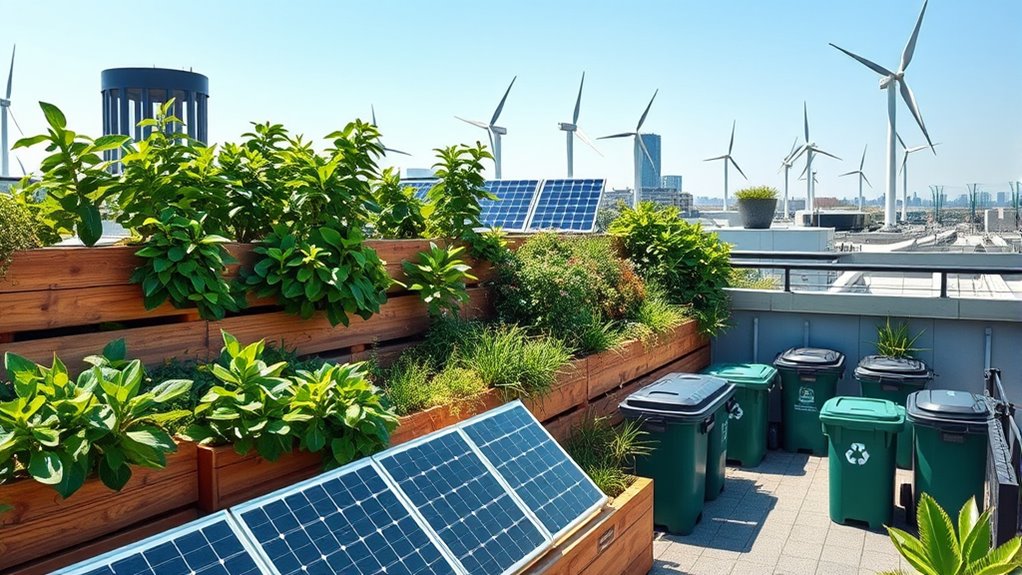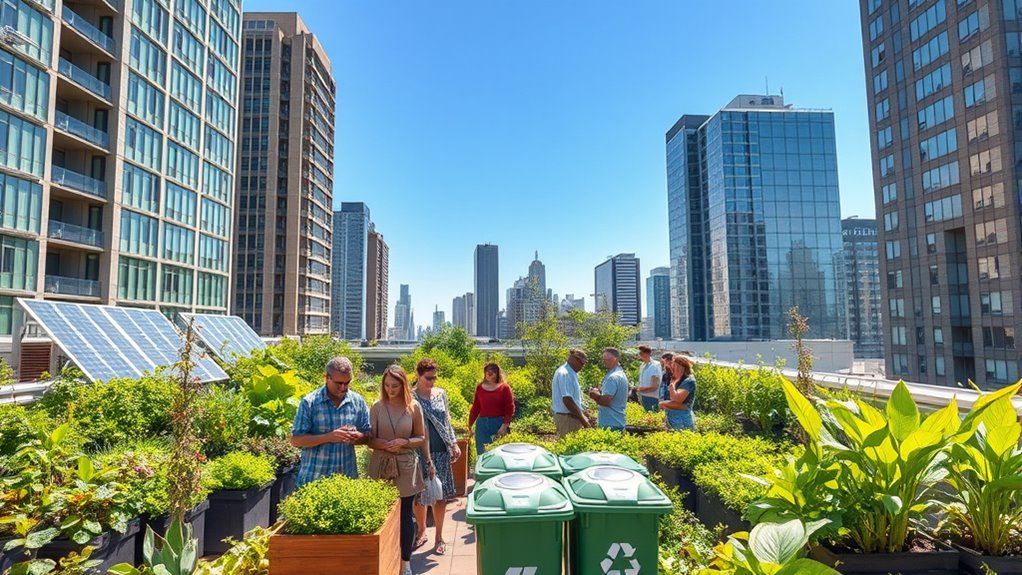To support green growth, adopt a circular economy approach by designing products that are repairable, reusable, and recyclable, which reduces waste and conserves resources. Collaborate with suppliers and consumers to promote sustainable practices, leveraging technology to optimize resource flow. Shift toward shared use models like leasing or product-as-a-service to maximize asset utilization. Embracing these strategies can boost innovation, cut costs, and enhance your brand’s reputation—plus, exploring further can reveal even more opportunities for sustainable success.
Key Takeaways
- Transition from linear to circular models by designing products for reuse, repair, and recyclability to reduce waste and resource extraction.
- Foster collaboration across supply chains and consumers, leveraging digital technologies to optimize resource flow and promote responsible behaviors.
- Implement sustainable sourcing of materials and develop business models like leasing or product-as-a-service to maximize asset utilization.
- Drive innovation in product design and business strategies to create new revenue streams while reducing environmental impact.
- Communicate the value of circular practices to stakeholders, reinforcing brand reputation and supporting long-term green growth.

Sustainability has become an essential goal for businesses and societies aiming to reduce environmental impact, and the circular economy offers a practical way to achieve it. As someone involved in today’s economic landscape, you understand that traditional linear models—where products are made, used, and discarded—are no longer sustainable. Instead, the circular economy emphasizes designing out waste, keeping resources in use for as long as possible, and regenerating natural systems. This approach not only helps protect the environment but also creates economic opportunities by maximizing resource efficiency. When you adopt circular principles, you’re encouraging innovation in product design, supply chain management, and business models that prioritize reuse, refurbishment, and recycling.
You might start by examining your current processes and identifying waste streams or inefficiencies. For example, consider how materials could be reused or repurposed instead of disposed of after a single use. This mindset shift can lead to the development of products that are easier to repair, upgrade, or disassemble, making it simpler to reclaim valuable materials down the line. In doing so, you contribute to reducing the demand for virgin resources, which helps preserve natural habitats and lowers carbon emissions associated with extraction and manufacturing. The circular economy also promotes the idea of shared use—such as leasing or product-as-a-service models—so that assets are utilized more intensively, reducing the need for new production.
Implementing these strategies requires collaboration across sectors and industries. You’ll need to work with suppliers to source sustainable, recyclable materials and with consumers to foster behaviors that support recycling and responsible disposal. Digital technologies like IoT and data analytics can play a crucial role in tracking resources and optimizing their flow through the system. By sharing insights and best practices, you can accelerate the transition toward a circular economy that benefits all stakeholders. Additionally, understanding the importance of creative storytelling can help communicate the value of circular practices to customers and partners, inspiring wider adoption.
Furthermore, embracing circularity can lead to cost savings and new revenue streams. For instance, designing products for durability and ease of repair can extend their lifespan, reducing replacement costs. Offering maintenance or refurbishment services can open up additional business avenues. When you align your operations with circular principles, you’re not just complying with regulations but also positioning your organization as a leader in sustainable development. This proactive stance resonates with consumers increasingly seeking environmentally responsible brands. Ultimately, adopting circular economy strategies isn’t just about environmental stewardship; it’s about future-proofing your business and contributing to a more resilient, sustainable economy.
Frequently Asked Questions
How Can Small Businesses Implement Circular Economy Practices Effectively?
You can implement circular economy practices by starting with waste reduction and recycling efforts. Partner with local suppliers to reuse materials and design products for longevity. Educate your team on sustainable practices and encourage innovation. Track your progress to identify areas for improvement. By integrating these steps into your daily operations, you’ll reduce costs, minimize environmental impact, and build a reputation for eco-consciousness that attracts loyal customers.
What Are the Main Challenges in Transitioning to Sustainable Supply Chains?
You’ll face challenges like higher initial costs, complex supplier coordination, and limited availability of sustainable materials. Resistance to change within your organization can also slow progress. Steering regulatory requirements and ensuring transparency adds to the hurdles. To succeed, you need to build strong supplier relationships, educate your team, and invest in sustainable practices. Overcoming these obstacles requires persistence, strategic planning, and a clear commitment to long-term environmental benefits.
How Do Circular Economy Strategies Impact Job Creation and Employment?
You might think circular economy strategies limit jobs, but they actually boost employment opportunities. By emphasizing reuse, recycling, and remanufacturing, you create new roles across supply chains. This shift encourages innovation and skills development, leading to diverse job creation. As you adopt circular practices, you’ll find that your workforce becomes more adaptable, resilient, and prepared for future green growth, ultimately benefiting your business and the broader economy.
What Role Do Governments Play in Promoting Green Growth Initiatives?
Governments play a vital role in promoting green growth initiatives by creating supportive policies and regulations. They fund research, incentivize sustainable practices, and set standards that encourage businesses to adopt eco-friendly methods. You can advocate for stronger government involvement by supporting policies that prioritize renewable energy, waste reduction, and green innovation. Their leadership helps shift industries toward sustainable development, ensuring economic growth aligns with environmental preservation.
How Can Consumers Influence the Shift Toward Sustainable Products?
You can influence the shift toward sustainable products by supporting brands committed to eco-friendly practices, as 73% of consumers say they’re willing to pay more for sustainable options. Your purchasing choices send a powerful message to companies to prioritize green initiatives. Sharing your values on social media and encouraging friends to buy eco-conscious products also amplifies demand. The more you choose sustainability, the faster businesses will adapt to meet your expectations.
Conclusion
By embracing sustainability and circular economy strategies, you can drive green growth and reduce environmental impact. While traditional models focus on consumption and waste, adopting circular practices emphasizes renewal and resilience. It’s a bold shift—challenging the status quo but offering endless opportunities for innovation and long-term prosperity. So, don’t just follow the trend; lead the change. Because in a world where resources are finite, the real growth comes from thinking differently and acting sustainably.










